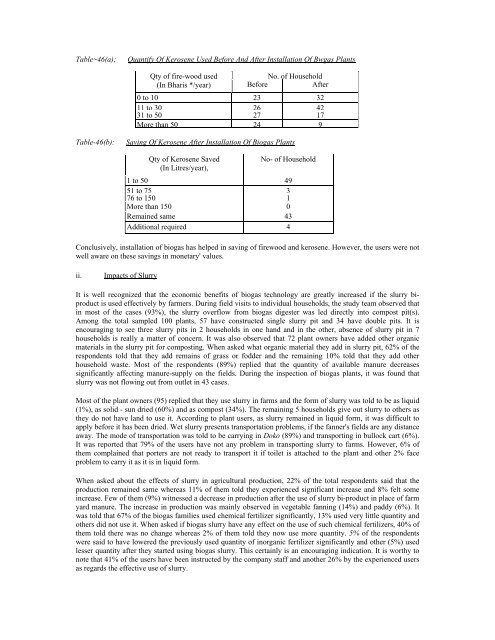download (pdf, 11MB) - SNV
download (pdf, 11MB) - SNV
download (pdf, 11MB) - SNV
You also want an ePaper? Increase the reach of your titles
YUMPU automatically turns print PDFs into web optimized ePapers that Google loves.
Table~46(a);<br />
Quantify Of Kerosene Used Before And After Installation Of Bwgas Plants<br />
Qty of fire-wood used<br />
No. of Household<br />
(In Bharis */year) Before After<br />
0 to 10 23 32<br />
11 to 30<br />
31 to 50<br />
26<br />
27<br />
42<br />
17<br />
More than 50 24 9<br />
Table-46(b):<br />
Saving Of Kerosene After Installation Of Biogas Plants<br />
Qty of Kerosene Saved<br />
(In Litres/year),<br />
No- of Household<br />
1 to 50 49<br />
51 to 75<br />
76 to 150<br />
3<br />
1<br />
More than 150 0<br />
Remained same 43<br />
Additional required 4<br />
Conclusively, installation of biogas has helped in saving of firewood and kerosene. However, the users were not<br />
well aware on these savings in monetary' values.<br />
ii.<br />
Impacts of Slurry<br />
It is well recognized that the economic benefits of biogas technology are greatly increased if the slurry biproduct<br />
is used effectively by farmers. During field visits to individual households, the study team observed that<br />
in most of the cases (93%), the slurry overflow from biogas digester was led directly into compost pit(s).<br />
Among the total sampled 100 plants, 57 have constructed single slurry pit and 34 have double pits. It is<br />
encouraging to see three slurry pits in 2 households in one hand and in the other, absence of slurry pit in 7<br />
households is really a matter of concern. It was also observed that 72 plant owners have added other organic<br />
materials in the slurry pit for composting. When asked what organic material they add in slurry pit, 62% of the<br />
respondents told that they add remains of grass or fodder and the remaining 10% told that they add other<br />
household waste. Most of the respondents (89%) replied that the quantity of available manure decreases<br />
significantly affecting manure-supply on the fields. During the inspection of biogas plants, it was found that<br />
slurry was not flowing out from outlet in 43 cases.<br />
Most of the plant owners (95) replied that they use slurry in farms and the form of slurry was told to be as liquid<br />
(1%), as solid - sun dried (60%) and as compost (34%). The remaining 5 households give out slurry to others as<br />
they do not have land to use it. According to plant users, as slurry remained in liquid form, it was difficult to<br />
apply before it has been dried. Wet slurry presents transportation problems, if the fanner's fields are any distance<br />
away. The mode of transportation was told to be carrying in Doko (89%) and transporting in bullock cart (6%).<br />
It was reported that 79% of the users have not any problem in transporting slurry to farms. However, 6% of<br />
them complained that porters are not ready to transport it if toilet is attached to the plant and other 2% face<br />
problem to carry it as it is in liquid form.<br />
When asked about the effects of slurry in agricultural production, 22% of the total respondents said that the<br />
production remained same whereas 11% of them told they experienced significant increase and 8% felt some<br />
increase. Few of them (9%) witnessed a decrease in production after the use of slurry bi-product in place of farm<br />
yard manure. The increase in production was mainly observed in vegetable fanning (14%) and paddy (6%). It<br />
was told that 67% of the biogas families used chemical fertilizer significantly, 13% used very little quantity and<br />
others did not use it. When asked if biogas slurry have any effect on the use of such chemical fertilizers, 40% of<br />
them told there was no change whereas 2% of them told they now use more quantity. 5% of the respondents<br />
were said to have lowered the previously used quantity of inorganic fertilizer significantly and other (5%) used<br />
lesser quantity after they started using biogas slurry. This certainly is an encouraging indication. It is worthy to<br />
note that 41% of the users have been instructed by the company staff and another 26% by the experienced users<br />
as regards the effective use of slurry.
















